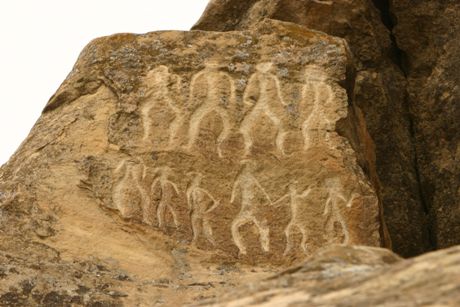Gobustan: Ancient human habitat and land of historical monuments

By Nigar Orujova
Azerbaijan, a country with rich history, has a number of settlements with traces of prehistoric men. The earliest evidence of human settlement in the territory of Azerbaijan dates back to the Stone Age and is related to the world-famous Azykh Cave.
From that ancient period people settled in all parts of Azerbaijan, with one of the most known settlements being Gobustan, or "the land of dry riverbed". It is located some 64 km southwest of the Azerbaijani capital Baku in the area of 537 hectares lying between the southern slope of Great Caucasus ridge and the Caspian Sea at the average height of 600-700 meters.
Gobustan, which gained worldwide recognition when it was included in the World Heritage List by UNESCO in 2007, is famous for its 6,000 rock engravings and evidence of human habitation that spans 25,000 years. In addition to the rock carving art, archaeological excavations have revealed inhabited caves, settlements, and burials -- all reflecting intensive use of the area by inhabitants during the humid weather period that followed the last Ice Age, which occurred from the Upper Paleolithic to the Middle Ages.
Archeological studies of the region started in 1939-1940 by a pioneer Azerbaijani archeologist, Iskhag Jafarzadeh. Systematic studies of the Gobustan rock carvings were delayed because of World War II, but were resumed in 1947 and are still ongoing.
Jafarzadeh excavated and discovered rock paintings as well as Arab inscriptions refering to different periods of Azerbaijani Middle Age history, as well as a Roman inscription which proves the presence of the XII Roman legion in Azerbaijan at the end of the I century. More than 3,500 images on 750 rocks were recorded and analyzed at that time.
Gobustan rock carvings stand out for their thematic diversity, plot originality, and certain artistic skill of their makers.
During the exploration work, archaeologists have uncovered on-rock depictions of primitive men, animals, battles, ritual dances, bullfights, boats with armed oarsmen, warriors with lances in their hands, camel caravans, pictures of the sun and stars.
These rock engravings show a way of life and activities of ancient humans related to hunting and fishing, and helped to better interpret the images and imagine the lifestyles of earlier inhabitants.
Here one can find ceremonial dances by one person or by groups that remind of the modern Azerbaijani folk dance "Yally".
Along with ancient rock carvings, Gobustan is rich in settlements and dwelling places of people who lived and created in the course of the last 34,000 years and also other historical and archaeological monuments.
Archaeological excavations there started in 1960 and about 20 caves that date back to periods from the end of Upper Paleolith until Middle Ages, more than 40 monuments of a burial-mound type referring to the Bronze Age and later periods and two tomb monuments of the Stone Age were discovered.
There are also 436 dug ancient cupules and two-side holes on the rocks usually encountered in front of the Gobustan caves, which are considered Stone Age settlements. These were deemed the most primitive cupules for gathering rain waters and blood of sacrificed animals.
More than 40 cemeteries of burial-mound type were also explored in Gobustan.
During archaeological excavations it was determined that the cover of the Gobustan burial mounds is not a mere gathering of stones as it bears the shape of a built structure.
The assumption that the Gobustan rock carvings were created by divine power in later historical periods became the reason for establishment of sanctuaries or places of worship.
Generally, there is a great number of sanctuaries in the territory of Gobustan belonging to the pre-Islamic period as well as such sanctuaries as "Gara atli", "Sofu Hamid" and "Sofu Novruz" that retained their function and form and were originally established in the Muslim period.
Nowadays, Gobustan has dry semi-subtropical climate, but the presence of rare and wild flora indicates that in the remote past the climate of Gobustan was more humid and the flora and fauna of that time were incomparably richer and sufficient for the tribes living there.
However, Gobustan is not only known for its engravings, caves and sanctuaries. The historical richness of the region is multiplied by Gaval Dash and numerous mud volcanoes.
Gaval Dash, an ancient musical intsrument, is the only precious stone which makes a tambourine-like sound as a result of its placement on an air pillow. It was played by the ancient Gobustan people during festivities and for Yally dance as well as during many other ceremonies, which is reflected in the rock carvings.
Azerbaijan has nearly 400 mud volcanoes, which is around half the world's total. While most of the mud volcanoes are small, the largest one in Azerbaijan and the world, called Toragay, spans one kilometer across the base and reaches 400 meters in height and is located in Gobustan.
For centuries, Gobustan withstood the sun, wind, seismic activity and various kinds of precipitation. In 1966, the outdoor museum located in the area was declared a state historical preserve.
Here we are to serve you with news right now. It does not cost much, but worth your attention.
Choose to support open, independent, quality journalism and subscribe on a monthly basis.
By subscribing to our online newspaper, you can have full digital access to all news, analysis, and much more.
You can also follow AzerNEWS on Twitter @AzerNewsAz or Facebook @AzerNewsNewspaper
Thank you!
